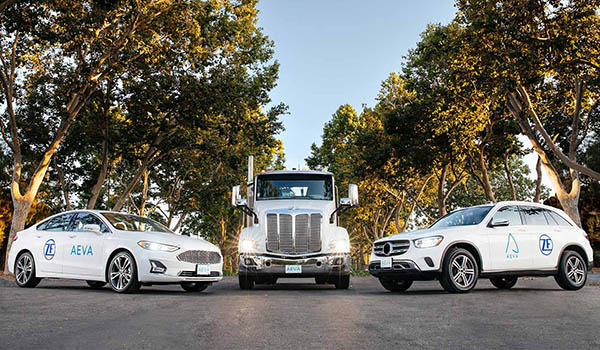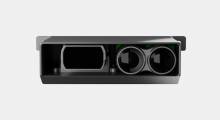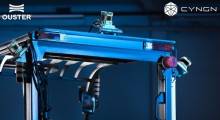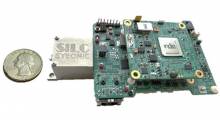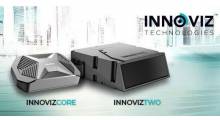Aeva Technologies Inc. today introduced its Aeries II sensor. The Mountain View, Calif.-based company described it as a 4D lidar sensor that can detect velocity in addition to 3D position to help make autonomous systems like vehicles and robots smarter and safer.
“Aeries II is a leap forward for the industry, and we believe it will play a critical role in unlocking the next wave of automation across a variety of applications, from automotive to industrial and beyond,” said Mina Rezk, co-founder and chief technology officer of Aeva.
Former Apple engineers Rezk and Soroush Salehian founded Aeva in 2017. Led by a multidisciplinary team of engineers and operators experienced in the field of sensing and perception, the company said its mission is to apply next-generation technology to applications including automated driving, consumer electronics, healthcare, industrial automation, and security.
Aeries II puts FMCW on a chip
Aeva claimed that its technology integrates key lidar components onto a silicon photonics chip in a compact module. The company said Aeries II uses frequency modulated continuous wave (FMCW) technology and can detect the fourth dimension of instantaneous velocity for each point in addition to its 3D position.
In addition, Aeva said its Advanced 4D Perception software can provide camera-level images with up to 20 times the resolution of legacy lidar sensors.
“Aeva's unique FMCW technology has inherent advantages like instant velocity detection for each point that allow us to deliver several crucial breakthroughs for our customers such as Ultra Resolution and 4D Localization, which have not been possible until today,” said Rezk. “Aeries II provides our customers with a new level of perception to help automated vehicles and machines make safer, more intelligent decisions with higher confidence.”
Aeva offers advanced perception software
Aeva said its proprietary perception software uses raw 4D sensor data to deliver capabilities not possible with time-of-flight lidars.
Ultra Resolution: Aeries II offers a real-time, camera-level image of the world with up to 1,000 lines per frame and no motion blur for a static scene. Image segmentation enables the detection of roadway markings, drivable regions, vegetation, and road barriers.
The technology also allows for the detection of road hazards like tire fragments at up to twice the distance of conventional sensors, claimed Aeva. Instant velocity data allows for high-confidence detection and tracking of dynamic objects such as oncoming vehicles and other moving objects, the company said.
4D Localization: Per-point velocity data enables real-time ego vehicle motion estimation with six degrees of freedom, motion compensation, and on-line sensor extrinsic calibration to aid with sensor fusion, according to Aeva.
These vehicle-estimation features also allow for accurate vehicle positioning and navigation without the need for additional sensors, like inertial measurement units (IMUs) or GPS. This makes autonomous navigation in GPS-denied and featureless environments like tunnels possible, Aeva said.
“The improved safety, efficiency, and sustainability of our autonomous trucks are good for fleets, for the public, and for the environment,” said Shawn Kerrigan, co-founder and chief operations officer of autonomous truck developer PlusAI Inc. “Adding Aeva’s 4D lidar to our state-of-the-art long-range perception provides valuable instant velocity detection for an extra layer of redundancy. We are excited to work with Aeva to commercialize and deploy our autonomous driving technology globally.”
Velocity detection with long-range performance
Aeva said its next-generation 4D lidar “uniquely measures instantaneous velocity for each pixel in addition to 3D position, allowing automated vehicles and machines to perceive where things are and know precisely how fast they are moving.” Aeries II uses Aeva's FMCW technology to directly measure the velocity of each point with centimeter-pe-second precision, in addition to precise 3D position.
Aeries II delivers 4 million raw points per second, a maximum field of view of 120 degrees by 30 degrees, and a maximum detection range of up to 500 m (1,640.4 ft.). Aeva said it allows autonomous vehicles and mobile robots to operate across a broad set of conditions, including:
- Elimination of retroreflector blooming and ghosting from reflective objects like street signs and roadway markings, ensuring optimal performance in complex road environments where such object would degrade legacy lidar perception
- Greater ability to see through airborne particulates like dust, fog, rain, and snow, improving performance across a broad set of environmental conditions
- Freedom from interference from other lidar, including Aeva sensors, providing clear perception when operating near other lidar-equipped vehicles
- Freedom from interference from the sun when it is in the field of view of the sensor, such as during sunrise and sunset, performing across a wider set of lighting conditions
Lidar-on-chip design
Aeva claimed that lidar-on-chip design eliminates all fiber optics and places all key components, including transmitters, receivers, and optics, onto a silicon photonics chip in a compact module.
The company claimed that this design enables the manufacturing process to be fully automated, allowing it to scale up production of Aeries II.
Automotive-grade robustness
Aeries II is built for reliability, with automotive-grade thermal, shock, and vibration ratings to ensure peak performance across a variety of road and environmental conditions, said Aeva.
Robust IP67 ingress and IK07 impact ratings protect the sensor from dust, water, and other particles, the company added. Aeries II is also designed to meet the requirements of ISO 16750 standards to ensure durability throughout operation.
Aeries II designed for integration
At a quarter of the size of the previous generation, the new sensor's compact design allows for a wide range of integration options, said Aeva.
Real-time software configurable field of views, scanning patterns, and maximum detection ranges offer optimal performance across various autonomous applications, stated the company. These include advanced driver-assist sytsems (ADAS), autonomous vehicles, and mobility systems, as well as industrial automation, smart infrastructure, and warehouse robots.
Aeva unveiled Aeries II at its Product & Technology Day, and the new sensor will be available starting in mid-2022.
Article topics
Email Sign Up

